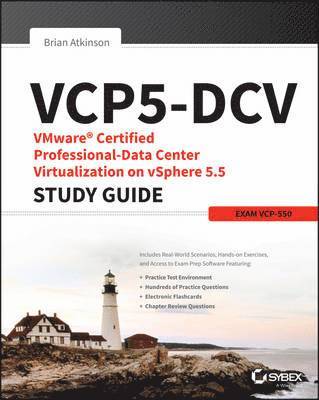
- Format
- Häftad (Paperback / softback)
- Språk
- Engelska
- Antal sidor
- 888
- Utgivningsdatum
- 2014-05-13
- Upplaga
- 2
- Förlag
- John Wiley & Sons Inc
- Illustratör/Fotograf
- figures black & white tables
- Illustrationer
- black & white tables, figures
- Dimensioner
- 234 x 184 x 44 mm
- Vikt
- Antal komponenter
- 1
- ISBN
- 9781118658444
- 1143 g
VCP5-DCV VMware Certified Professional-Data Center Virtualization on vSphere 5.5 Study Guide
Exam VCP-550
Kundrecensioner
Fler böcker av Brian Atkinson
-
Studying Economics
Brian Atkinson, Susan Johns
-
Economic Policy
Brian Atkinson, Bob Milward
-
Applied Economics
Brian Atkinson, Bob Milward
Övrig information
Brian Atkinson is a Senior Systems Engineer with 16 years of experience in the IT field. Since 2006, he has focused on virtualization, storage, and virtualization evangelism. Brian holds the VCP 3, VCP 4 and VCP 5 certifications and has also been awarded the vExpert designation from VMware in 2009, 2010, and 2011. He is a VMware Technology Network (VMTN) Moderator and active contributor. Brian is also a guest blogger at the VMTN. You can reach him on Twitter: @vmroyale.
Innehållsförteckning
Introduction xxxiii Assessment Test lvii Chapter 1 What s New in vSphere 5.5 1 vSphere ESXi Hypervisor Enhancements 3 Hot-Pluggable PCIe SSD Devices 3 Support for Reliable Memory Technology 3 Enhancements to CPU C-States 4 Virtual Machine Enhancements 4 VM Compatibility with VMware ESXi 5.5 4 Expanded vGPU Support 5 Graphic Acceleration for Linux Guests 5 vCenter Server Enhancements 5 vCenter Single Sign-On 5 vCenter Server Appliance 5 vSphere Web Client 6 vSphere App HA 6 HA Compatibility with DRS VM-VM Affinity Rules 6 vSphere Big Data Extensions 6 Storage Enhancements 6 Support for 62TB VMDK 7 MSCS Updates 7 16Gb E2E Support 7 PDL AutoRemove 7 vSphere Replication Interoperability 7 vSphere Replication Multi-Point-in-Time (MPIT) Snapshot Retention 7 VAAI UNMAP Improvements 8 VMFS Heap Improvements 8 vSphere Flash Read Cache 8 Networking Enhancements 9 Link Aggregation Control Protocol (LACP) Enhancements 9 Traffic Filtering 10 Quality of Service Tagging 10 SR-IOV Enhancements 10 Enhanced Host-Level Packet Capture 10 40Gb NIC Support 10 VMware Data Protection (VDP) Enhancements 10 vCenter Operations Manager 11 Summary 11 Chapter 2 Planning, Installing, Configuring, and Upgrading VMware ESXi and vCenter Server 13 Introducing VMware ESXi 15 Identifying ESXi Host Requirements 15 Performing an Interactive Installation of ESXi 16 Configuring NTP on an ESXi Host 25 Configuring DNS and Routing on an ESXi Host 26 Enabling, Configuring, and Disabling Hyperthreading 30 Selecting a CPU Power Management Policy 31 Enabling, Sizing, and Disabling Memory Compression Cache 33 Licensing an ESXi Host 35 Introducing vCenter Server 37 Identifying Available vCenter Server Editions 37 Identifying vCenter Server and vCenter Server Database Requirements 38 Identifying Single Sign-On Requirements 40 Creating a Database Connection to the vCenter Server Database 41 Sizing the vCenter Server Database 44 Installing vCenter Server into a Virtual Machine 46 Deploying the vCenter Server Appliance 52 Installing and Configuring the vSphere Client and vSphere Web Client 57 Describing Single Sign-On Architecture 59 Differentiating Single-Sign-On Deployment Scenarios 61 Configuring and Administering Single Sign-On 62 Managing Single Sign-On Users and Groups 65 Installing Additional vCenter Server Components 73 Installing and Removing vSphere Client Plug-Ins 78 Enabling and Disabling vSphere Client Plug-Ins 78 Licensing vCenter Server 80 Determining Availability Requirements for a vCenter Server in a Given vSphere Implementation 83 Planning and Performing Upgrades of vCenter Server and VMware ESXi 84 Identifying Steps Required to Upgrade a vSphere Implementation 85 Identifying Upgrade Requirements for ESXi Hosts 87 Determining Whether an In-Place Upgrade Is Appropriate in a Given Upgrade Scenario 88 Summary 90 Exam Essentials 90 Review Questions 91 Chapter 3 Securing vCenter Server and ESXi and Identifying vSphere Architecture and Solutions 95 Securing vCenter Server and ESXi 97 Configuring and Administering the ESXi Firewall 97 Enabling, Configuring, and Disabling Services in the ESXi Firewall 103 Enabling Lockdown Mode 106 Adding an ESXi Host to a Directory Service 109 Viewing, Sorting, and Exporting User and Group Lists 113 Identifying Common vCenter Server Privileges and Roles 114 Describing How Permissions Are Applied and Inherited in vCenter Server 116 Adding, Modifying, and Removing Permissions for Users and Groups on vCenter Server Inventory Objects 118 Creating, Cloning, and Editing vCenter Server Roles 123 Determining the Appropriate Set of Privileges for Common Tasks in vCenter Server 126 Identifying vSphere Architecture
Du kanske gillar
-
The Thinking Machine
Stephen Witt
Inbunden -
Empire of AI
Karen Hao
Häftad -
Nexus
Yuval Noah Harari
Häftad -
Careless People
Sarah Wynn-Williams
Inbunden -
Doppelganger
Naomi Klein
Häftad
